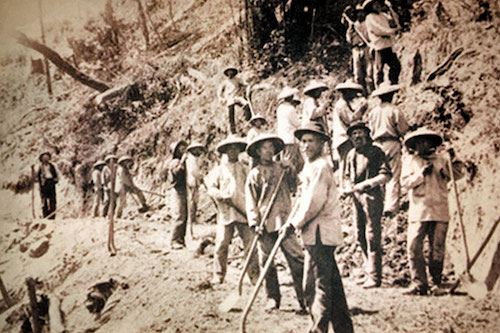Life was difficult for the Chinese Transcontinental Railroad workers. An article by Shoshi Parks published in the AtlasObscura web site describes the difficulties:
The winter of 1867 came bitter and merciless to the Chinese men that tunneled through the transcontinental railroad’s most formidable section, a nearly 1,700-foot stretch of granite at the Donner Summit in California’s Sierra Nevada Mountains. The men, immigrants from subtropical Guangdong, had never before known snow, let alone the relentless blizzards of the kind that, just 20 years before, forced the Donner party into cannibalism a few miles away.

The laborers, who worked around-the-clock to drill the tunnels by hand, were no strangers to suffering. Starvation, however, was one hardship they did not face—far from it. In the railroad camps, many of the men ate better than they ever had back home in southern China.
While the Transcontinental Railroad Company provided the largely Irish workers on the eastern section of the railroad with free meals and housing, they forced the Chinese workers on the western section to supply their own. The cost—around half of their $30 monthly wage—bit into their already meager earnings, but the company’s discriminatory decision not to feed the Chinese had an unexpected benefit. Many of the Irish laborers languished on an unvarying company-provided diet of boiled beef, potatoes, and water (with the occasional addition of liquor). But the Chinese workers opted for fresh local produce and livestock, as well as familiar ingredients shipped directly from Hong Kong to the labor camps, which kept them healthy and strong.
The wide variety of available food satiated the workers not just physically but mentally through the men’s practice of traditional Chinese medicine. A diet that balanced hot and cold foods and washed them down with carefully prepared herbal teas didn’t just keep the body, mind, and spirit at a healthy equilibrium, it was one of the few connections to home that they carried with them in the strange new land.
What and how the Chinese transcontinental workers ate has a clear signature in the archaeological record. In his work at the Donner Summit, archaeologist Scott Baxter found abundant evidence of the food containers, cooking equipment, and servingware required to feed the couple hundred Chinese men who worked and lived there at any given time. During the 16 months of grueling labor on the tunnels, Chinese workers were split up into teams of 12 to 20. Each crew had a designated cook who prepared food on keyhole-shaped wok stoves scattered among the wooden cabins built at the site.
You can read the full article at: https://www.atlasobscura.com/articles/diets-transcontinental-railroad.